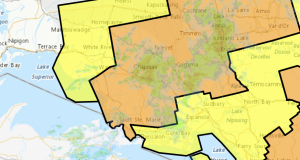It may seem odd to share with Northern Ontarians a recent article I wrote for the Toronto Star about a transportation agency in Southern Ontario. But the reasons are many and my concern from a northern viewpoint is extreme because this politically-driven juggernaut has been expanding its empire out of sight – with billions of our tax dollars – through its links to other agencies, including the Ontario Northland Transportation Commission (ONTC).
As I explained to Toronto Star readers, Metrolinx is an octopus-like agency that is sliding its tentacles into so many questionable areas in doing the bidding of Premier Doug Ford and heaven only knows which corporate “friends of the family.”
This is a publicly-funded agency that, by the count of the Office of the Auditor-General in 2019, employed 78 communications, government relations, and community relations staffers – more than are employed by all of North America’s Big Seven freight railroads, VIA Rail and Amtrak combined. Examining the annual Ontario Sunshine List (the number of employees making $100,000 or more annually) has grown from 90 in 2009 to 1,144 in 2020.
Northerners should be especially concerned because Metrolinx is gradually taking control of various aspects of the ONTC, including the $5-million series of four so-called initial business cases for the relaunch – if ever – of the Northlander passenger train axed under suspicious circumstances by the McGuinty Liberals in 2012.
I’ll have more to say on this front in the near future. Here’s my warning to Torontonians, which applies equally to Northern Ontarians.
***
Now that the Metrolinx octopus has said it will slide its tentacles under Queen Street and rip it open for five years of construction for its Ontario Line, a few Torontonians are becoming alarmed. It’s about time.
This provincial predator was dangerous when hatched by Dalton McGuinty in 2006. It has turned deadly as Doug Ford’s government has inflated it through various development industry schemes and sleight-of-hand public-private partnerships (P3s).
A recent Star editorial suggested Toronto City Council call on Metrolinx “to have another crack at its plan.” With Metrolinx, this is like asking a shark to reconsider before it dines on you.
Metrolinx was never required. Many said so at a “blue sky expert roundtable” session the Harris government had me design and host at the Royal York Hotel in 2002. That was after they slashed provincial transit funding and then thought twice as they faced an election.
Four attendees destined for senior Metrolinx positions agreed GO Transit should be expanded to play a larger role in regional transportation, leaving local transit to municipal decision-makers and avoiding the creation of another layer of bureaucracy. But it still was spawned after McGuinty was elected in 2003.
Metrolinx has always been voracious and vicious. Its first chair wrote a memo advising staff to “salt” their public consultation sessions with supporters to avoid having their plans “hijacked by nimbies or local politicians on the make.” He denied it when a reporter got a copy.
These Liberal Metrolinx empire builders were replaced by Ford versions after the 2018 election. But not all. One carryover is behind the Ontario Line, which he crafted to replace a TTC heavy rail subway plan that sat on the shelf for decades. To use a bit of Metrolinx bafflegab, this “embedded consultant” has an automated light rail fixation, so the subway was replaced by an automated mini-metro.
It is supposed to divert traffic from the Bloor-Danforth and Yonge subways by wandering through downtown between Ontario Place and the Ontario Science Centre. It copies a Montreal P3 project that has destroyed Canada’s only electrified commuter rail line, ripped open sections of the city and imported rolling stock from India.
Whatever the technology, there is simply no need for the Ontario Line; there is a cheaper and faster way to deliver all we’ve been promised it will deliver. It’s a GO plan from 1985 when another vote-chasing scheme known as Network 2011 was trundled before voters. Designed by the TTC and endorsed by the province, it called for a Downtown Relief Line heavy rail subway plus others on Sheppard East and Eglinton West
GO proposed connecting and boosting frequency on the inner sections of its rush-hour-only Georgetown and Richmond Hill commuter rail services, diverting the latter up the CP Don Branch from Union Station to Leaside. It could have been extended to Don Mills on a CN line the City of Toronto has since turned into a pathway.
Conventional commuter trains plying this route would have eliminated the need for Network 2011’s expensive subways, intercepting riders at points where the rail lines crossed the streets to be served by the subways.
Recast to reflect changes that have occurred in 36 years, this plan still makes operational and financial sense. Furthermore, Metrolinx now owns the CP Don Branch but is proposing to convert it into a single-track yard to store GO trains nose-to-tail, elephant-style.
If you’re wondering about the public cost of all these promised projects, have no fear. Metrolinx issued a puff piece recently setting the total cost – for now – at $75 billion.
I could go on, but let me put it succinctly: “Stop the Ontario Line now!” And replace out-of-control Metrolinx with a transparent, accountable agency staffed by professionals with real-world experience, not resumes with the embarrassing question marks buffed off to make them look like pros.
The costs to date for the Ontario Line are sunk and can never be recovered. But spending more on it would be even more fiscally irresponsible and strategically deadly in a transportation sense.
With all that is riding economically, socially and environmentally on our transportation decisions today, we can’t afford that risk.
- The Great Train Robbery – Part 2 - June 12, 2023
- The Great Train Robbery – Part 1 - March 19, 2023
- Railroaded: A National Train Wreck - February 3, 2023
 Wawa-news.com You can't hear the 'big picture'!
Wawa-news.com You can't hear the 'big picture'!

